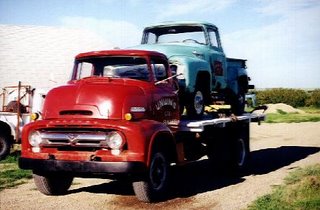
In Canada, Mercury made trucks as well as cars... unlike the US where Mercury isn't known for trucks.
http://www.mercurypickup.com/ there's a lot of info here.
I have an affinity for the COE, Cab Over Engine,( truck ) most were haulers, and few survive from any manufacturer. So coming across this pic of the Mercury COE amazed me, and I think I should show you guys the strange thing that is a 1) Canadian vehicle 2) A Mercury truck, 3) A COE.
Canadian divisions of the big 3 had strange names and some unusual combinations of american parts on models you wouldn't find those parts on with US models of the same year. Wierd and interesting stuff.
Here's a bit of Ford truck info... most of this is obsolete info, but still neat to learn.
In 1948 Ford introduced a restyled Pickup which continued through 1952. During this period Ford introduced the "F" prefix. The 1/2 ton was called an F-1. The medium duty 3/4 ton trucks were referred to as an F-2. The F-3 designation meant a one ton truck. The "F" series continued through F-8 for big trucks.
Between 1948 and 1968 Ford of Canada used the "F" prefix for Ford and "M" for Mercury. In 1948-49-50 nominal tonnage ratings have been replaced by a series designation, the code numbers indicates the G. V. W. when equipped with tires of appropriate capacity rating. Each code number is arrived at by dividing the rated G. V. W. of the series by 100. Thus F-47 (M-47) indicates a G. V. W. of 4700 lbs., F-135 (M-135) indicates 13500 lbs., etc. Each truck series is rated to its G. V. W. In 1951-52 Ford got back in step with Ford of USA with F-1 (M-1), F-2 (M-2) and so forth. (G. V. W. - Gross Vehicle Weight - weight of chassis, cab and body, plus payload)
The next Pickup style covered the years 1953-1956. The cabs were totally restyled. The front windshield was now smartly slanted, increasing the windshield area tremendously. The "F" series numbers were modified to F-100, F-250, F-350, and so on.







